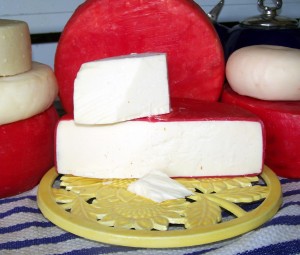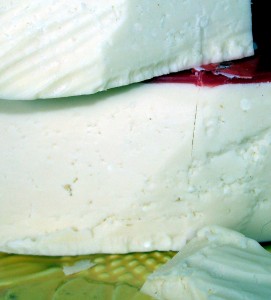After following all the directions given for making cheeses last fall, to include covering the various wheels with wax we stashed the results on the bottom shelf of the refrigerator to age. This is a very necessary step, or so we are assured: one or two of our ventures into D-I-Y cheesery had to age for up to a year to achieve perfection the smoked gouda and the parmesan, for example although most needed only about three months or so. The largest mold that we have does a two-pound wheel very nicely: that is, the curds which result from applying judicious amounts of heat, starter, rennet, and cheese salt to four gallons of whole milk fill it up to the top. This, when weighted and pressed to extract the remaining whey and compact the cheese curds, results in a cheese wheel about twelve inches around, and from two to almost five inches thick. It must sit and dry for a couple of days at room temperature, once taken out of the mold, before being waxed, labeled with the date (and how many months it must age!) before being stuck in the refrigerator to age.
This week, we cut into the first wheel of cheddar; and was it good! It wasn’t very much like commercial cheddar from the supermarket, which usually has a smooth and kind of gelatinous texture, as well as a pronounced orange tint. Ours came out rather more like very, very expensive artisan Cheddar, with a slightly crumbly grain to it somewhat like feta, but much firmer and a lovely, creamy taste to it. It was mild, rather than sharp, it melts beautifully, and when I decided to make macaroni and cheese with it last night … I am telling you food of the gods. The only disadvantage is that we will probably eat this up faster than we can make and age more. We rather like making things ourselves bar the one or two flops. While it is cheaper to buy ready-made ordinary items like cheese … it is absolutely less expensive to make the good stuff yourself. And you know exactly what goes into it.
Now, my daughter is looking speculatively at the canning supplies that are on display in our local HEB and wondering just how hard home-canning could be. It isn’t, although there are some things, like green beans, which if badly done, can give you botulism. I’d rather stick to fool-proof things; jams, jellies and pickles. And just last night, I went and looked up some recipes for making whole-grain mustard.


If Hussein is re-elected, you will need that skill set.
Yep. We figure in the case of this, or the zombie apocalypse that our mad brewing skilz will come in handy, too.
Curiously, the local home-brewing and cheese-making supply store is doing booming business. They opened about four years ago, and business for them has gotten better every year. In afternoons and on weekends, the place is never empty.
So when’s the party?
I’ll bring the crackers.
Wonder how many kinds of cheeses there are – 1000s?
My neighbor likes this Greek cheese – Casaba? (oh wait that’s a melon but it sounds similar)
This year, we made mini-cheeses and loaves of home-made bread for our neighbors, Bill.
Greek cheese, sounds like casaba … maybe you mean kasseri?
That’s the one Sgt! And that cheese is priced almost like gold. $7 for just a few ounces.
A nice white wine – Pinot Noir? – sounds like a good complement to your delectable cheese!
After the big die, you are welcome to Wisconsin, where I will have beef and eggs to trade you for booze and cheese. Ah hell who am I kidding, you have the booze, I will make the trip down there.
Sgt. Mom,
What are you using for your raw material? Are you buying milk or raising critters to furnish it?
Subotai Bahadur
SB – we’re just using commercial whole milk: Sam’s Club has the best deals. I’d love to get a local source for goat milk, so we can do those cheeses, but the only kind on the store shelves is the super-pasturized stuff, which doesn’t work in cheese-making.
If you had the room and resources to raise your own livestock, I was going to recommend that you take a look at the Dexter breed of cattle.
http://www.motherearthnews.com/Sustainable-Farming/2001-12-01/Ideal-Small-Farm-Cows-Dexter-Cattle.aspx
They strike me as appropriate things to have when things get “interesting”.
As far as goats milk; I believe you are in Texas near San Antonio, if I am correct. If the local health food stores cannot line up a source for goats milk, check with the any local carniceria that sells cabrito. They will know who is raising goats in the area, and some of them will also be selling goats milk.
Subotai Bahadur
Thanks, SB – I think the guys who run the home-brew and cheese-making supply store also have a line on local goat-milk, too. And at the Lockhart Evening with the Authors event last October, I swapped business cards with some local farmers who have goats.
Speaking of the home-brew/cheese-making supply store, they are doing a heck of a business these days. We stopped in this mid-morning for starter, and there were half a dozen people there! On weekends, the place is jammed. Something tells me that a heck of a lot of people are preparing for the zombie apocalypse by brushing up on their food and drink prepping skilz.
Oh, and I forgot to add one of the other useful things about home-cheesemaking: save the whey, when you pour it off the milk solids. We keep a jug in the fridge to use for making bread and pizza dough, instead of milk or water. Makes darned good bread, too.
Back the old days, people who were raising a pig or two on the farm and making their own cheese would feed the whey to the pigs. Apparently it is very, very very good for the pigs.
Hmmm … maybe we should spare some for the dogs, too.